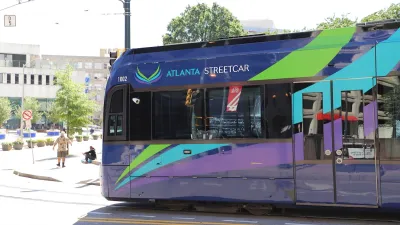Renee Lewis Glover, president and CEO of the Atlanta Housing Authority, reflects on the troubled history of housing projects in Atlanta, GA, as the last of its kind in the city is demolished.
"Atlanta has risen from its own ashes many times - most spectacularly after the Civil War. But there have been other occasions when the will of the people to do the right thing has fostered civic rebirth. While many Southern cities were mired in racial unrest and race riots, for example, Atlanta said, "We can do better," and we did.
Another example: During the Great Depression, one third of the nation was ill-housed. In Atlanta, the tenements were atrocious and the shortage of housing was critical. When the federal government authorized public housing construction during the mid-1930s, Atlanta's spirit of resurgence led the way. We built the first major public housing project, on 60 acres of blighted land near Georgia Tech that eventually became Techwood/Clark Howell Homes. Over time, Atlanta had more public housing units per capita than any other American city, and for many years these projects were transitional housing for the working poor, who were striving to achieve self-sufficiency and the American dream."
"As Atlanta was preparing to host the 1996 Centennial Olympic Games, the Atlanta Housing Authority was ranked as one of the worst large public housing authorities in the entire country. Nearly all the schools serving students living in AHA properties were ranked among the worst in the entire state.
Just 12 years later, those dismal statistics have dramatically improved. AHA is now the national model for creating healthy mixed-use, mixed-income communities. More importantly, recipients are entering and succeeding in the work force and are on their way to achieving their version of the American Dream."
FULL STORY: New public housing at heart of a civic rebirth

Alabama: Trump Terminates Settlements for Black Communities Harmed By Raw Sewage
Trump deemed the landmark civil rights agreement “illegal DEI and environmental justice policy.”

Study: Maui’s Plan to Convert Vacation Rentals to Long-Term Housing Could Cause Nearly $1 Billion Economic Loss
The plan would reduce visitor accommodation by 25% resulting in 1,900 jobs lost.

Why Should We Subsidize Public Transportation?
Many public transit agencies face financial stress due to rising costs, declining fare revenue, and declining subsidies. Transit advocates must provide a strong business case for increasing public transit funding.

Paris Bike Boom Leads to Steep Drop in Air Pollution
The French city’s air quality has improved dramatically in the past 20 years, coinciding with a growth in cycling.

Why Housing Costs More to Build in California Than in Texas
Hard costs like labor and materials combined with ‘soft’ costs such as permitting make building in the San Francisco Bay Area almost three times as costly as in Texas cities.

San Diego County Sees a Rise in Urban Coyotes
San Diego County experiences a rise in urban coyotes, as sightings become prevalent throughout its urban neighbourhoods and surrounding areas.
Urban Design for Planners 1: Software Tools
This six-course series explores essential urban design concepts using open source software and equips planners with the tools they need to participate fully in the urban design process.
Planning for Universal Design
Learn the tools for implementing Universal Design in planning regulations.
Smith Gee Studio
Alamo Area Metropolitan Planning Organization
City of Santa Clarita
Institute for Housing and Urban Development Studies (IHS)
City of Grandview
Harvard GSD Executive Education
Toledo-Lucas County Plan Commissions
Salt Lake City
NYU Wagner Graduate School of Public Service





























